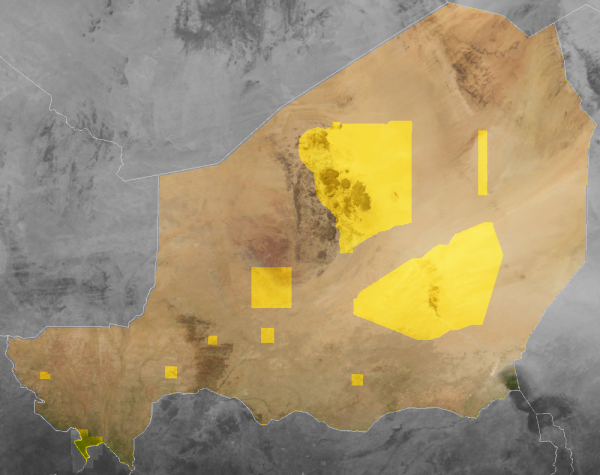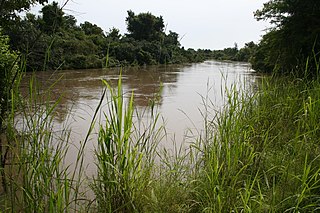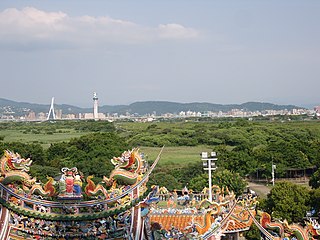Type and number of protected areas
Protected lands in Niger fall under both national and international regulation, and are managed by elements of the Nigerien government, as well as regional bodies and international designation oversight bodies. Initial classification of lands as legally protected for conservation of flora, fauna, landscape, and resource protection was done under French Colonial rule beginning in 1936. Much of the legal framework of land management and protection is based on these original regulations. As of the late 1990s, most land management was the area of the Nigerien Natural Resource Management Unit (Cellule de Gestion des Resources Naturelles) of the Inter-ministerial Sub-committee for Rural Development (Sous-Comité Interministériel chargé de la politique de Développement Rural au Niger), which includes ministries focused on environmental issues, industrial resource extraction, economic growth, and farming. Nigerien designated protected areas were administered by the Direction of Fauna, Fisheries and Aquaculture (Direction de la Faune, de la Pêche et de la Pisciculture - DFPP) of the Ministry of Hydrology and the Environment (Ministère de l'Hydraulique et de l'Environnement - MHE). Actual protection is the responsibility of the DFPP's Fauna and Apiculture Management Service (Service d'Aménagement de la Faune et de l'Apiculture - SAFA) which in 1987 had only 40 staff actually managing or guarding sites. [1]
Note: most sites have at least two overlapping designations.
National designations
Various Nigerien government designations, administered by the "Direction de l'Environnement" office of the Ministry of Hydrology and Environment [1]
- 4 Total Faunal Reserves, the equivalent of the World Commission on Protected Areas/IUCN Category IV - Habitat/Species Management Area
- 1 Partial Faunal Reserve, the equivalent of the World Commission on Protected Areas/IUCN Category IV
- 1 Faunal Reserve Buffer Zone
- 1 National Nature Reserve, the equivalent of the World Commission on Protected Areas/IUCN Category IV
- 1 Strict Nature Reserve, the equivalent of the World Commission on Protected Areas/IUCN Category Ia (Nature Reserve)
- 1 National Park, the equivalent of the World Commission on Protected Areas/IUCN Category II (National Park)

- 79 Forest Reserves (Forêts Classées) totaling 212,000 ha
- 51 restoration and land protection areas totaling 69,000 ha
International conventions and programmes
Additionally, several sites have international designations as protected areas. As signatories of the below conventions, the Government of Niger places restrictions on use of these lands.
- 12 Wetlands of International Importance (Ramsar). As a Convention signatory, Niger has agreed to establish wetlands protective areas, which may restrict use and promote "the wise use of wetlands in their territory". [2]
- 2 UNESCO World Heritage Convention sites, which are also the
- 2 UNESCO-MAB Biosphere Reserves. Both are listed under Natural criteria vii, ix, x. These are:
- VII. "to contain superlative natural phenomena or areas of exceptional natural beauty and aesthetic importance";
- IX. "to be outstanding examples representing significant on-going ecological and biological processes in the evolution and development of terrestrial, fresh water, coastal and marine ecosystems and communities of plants and animals";
- X. "to contain the most important and significant natural habitats for in-site conservation of biological diversity, including those containing threatened species of outstanding universal value from the point of view of science or conservation."
- 1 UNESCO World Heritage Convention site is also on the UNESCO List of World Heritage in Danger.
Other international conventions ratified by the Nigerien government include the Convention on Biological Diversity, the Convention on Migratory Species, CITES, the Convention to Combat Desertification, the Convention on Climate Change, the African - Eurasian Waterfowl Agreement, the African Convention on the Conservation of Nature and Natural Resources, the Convention on Game Hunting and the Convention on Plant Protection. [1]
Nongovernmental
A number of Nigerien sites are recognised by conservation programmes as conservation areas of special importance, even where there is no formal government convention. Notable among these are 15 BirdLife International designated Important Bird Areas (IBA). [3] Many of these are additional designations given to existing Nigerien government, IUCN, or Ramsar designated sites.











